Where to find Melbourne's best ramen
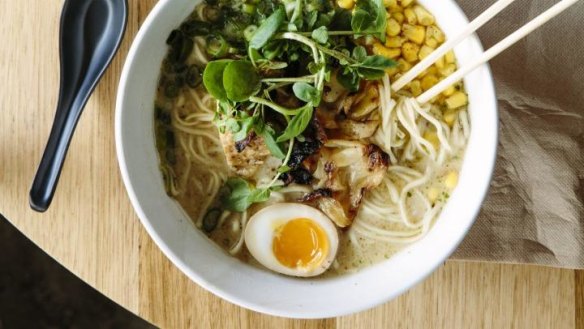
Masahiko Iga and Yoshi Kurosawa laugh and drink beer and slurp noodles loudly. The two Melbourne restaurant identities came to Australia from Japan about the same time at the beginning of the new century. Iga is a well respected sommelier; Kurosawa owns Robot Bar, and opened Mugen ramen bar in the CBD last year.
"Ramen for us is Japanese comfort food," says Iga, referring to the bowl of wheat noodles and chicken and pork broth in front of him. "Just as Italians miss their pasta and French miss their croissant or baguette, we Japanese miss our ramen," he says. "A few years back you couldn't get really good ramen in Melbourne."
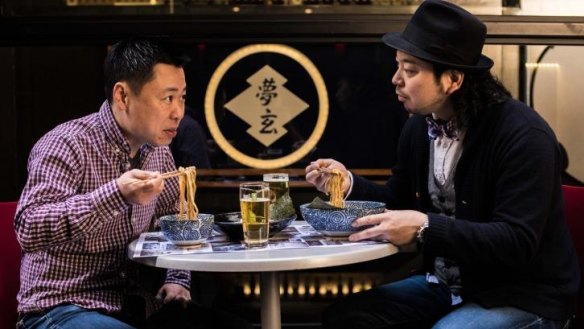
"There are Japanese people like me," says Kurosawa, "who so missed good ramen we had to take matters into our own hands and make our own and open our own ramen bars."
"There has also been a recent proliferation of Japanese-owned bars in Melbourne that has changed the landscape," Iga says.
Both men are adamant that the best ramen is made by Japanese chefs who understand the process of making the broth. This involves simmering bones and vegetables with other ingredients for hours to create what some have described as a masterpiece in umami. At its heart is a rich, complex, sticky broth that clings to the noodles, giving them voluptuous body.
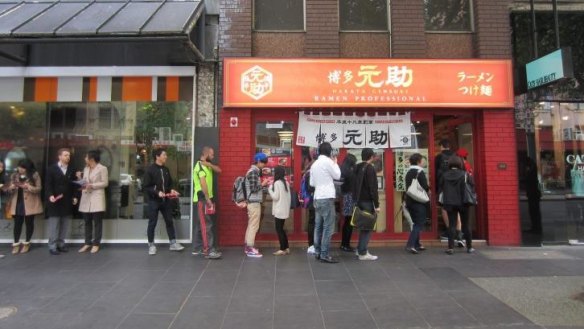
For the record, Kurosawa uses four kinds of dried fish: mackerel, flying fish, Pacific pike and bonito to create a rich, luscious and slightly smoky broth. Although he wouldn't give away the recipe he allowed us into the kitchen, where we saw a stockpot full of bones with several apples bobbing on top. "For acid and aroma," says Kurosawa. Near the stove is Kurosawa's noodle maker, dusted with flour from its daily use.
Although distinctly Japanese, with different variations in every prefecture, ramen has distinctly Chinese roots. Chinese traders brought the wheat noodle dish across the Sea of Japan at the end of the 19th century. Ramen really took hold across Japan after World War II, with subsidised American flour flooding the nation to stave off a swing towards communism. The invention of instant ramen in the late 1950s made the soup 'n' noodles in a polystyrene cup the go-to food in case of natural disaster. Ramen became the fast food of popular culture that was deeply nourishing both calorifically and psychologically. Ramen has spread rapidly in sushi's footsteps across the US in the past 10 years, coinciding with the fall of Japan as an economic threat and the rise of China, according to US food historian Professor George Stolt. Australia has doggedly followed the trend.
While the contents of ramen change from Japanese region to region, they generally share a similar structure. On top can be found meaty and pungent toppings. This could be soft-yolked eggs, roast pork, bamboo, garlic, spinach, spring onions, chives, fermented bean paste. The broth can vary from thinner and more delicate to a rich, thick sticky soup in which the pork fat has been completely emulsified. Sitting at the base is the "tare", also known as "kaeshi", a dollop of intense umami-inducing sauce that penetrates the broth the more it is mixed around. There are variants to the format, such as a Tokyo specialty called tsukemen in which the noodles are served separately, dipped into an intense broth.
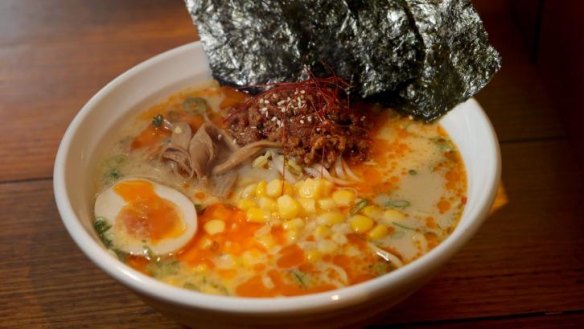
Masahiko Iga lets out a pleasing slurp as he heads to the bottom of his bowl. He describes ramen for him as everyman food that can be eaten any time of the day. However "I like shi-me ramen," he says. "This is a time to finish off a night of sake and beer in a bar by going and having a bowl of ramen with friends in the early hours of the morning. Ramen for me is not just the broth and the noodles. It is a casual time when you are with friends and you're just being yourself. Laughing. Telling funny stories. Becoming closer to the other people."
Top ramen places in Melbourne
Ramen bars are opening across Melbourne at a rapid pace. Some are large global Japanese chains; others are local restaurants owned by expat chefs. These are some of Japanese-born, Melbourne-based sommelier Masahiko Iga's favourites.
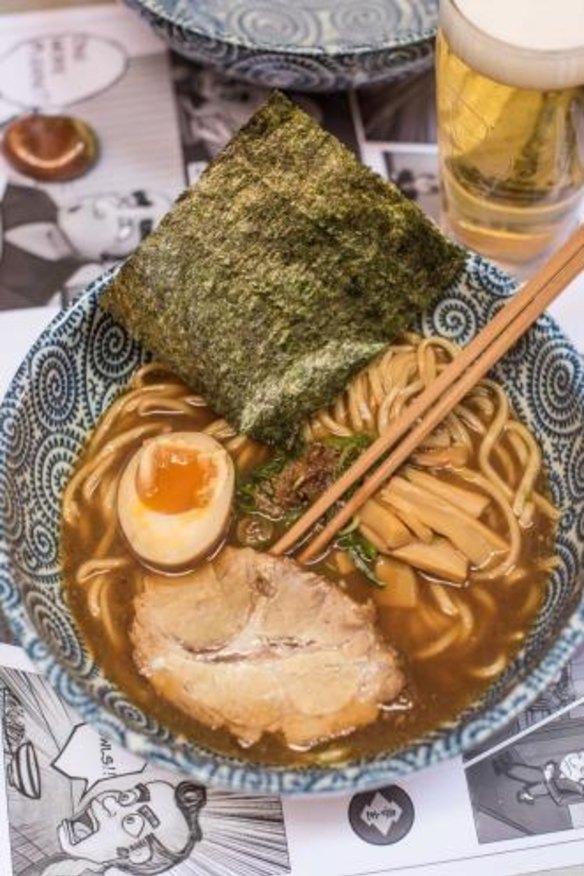
Mensousai Mugen
On a dead-end lane off Flinders Lane is this dark-walled and bare wood ramen wall with a vault-like dining room downstairs projecting classic Japanese movies on one wall. It's suits and corporates at lunchtime, and expat Japanese and ramen-loving hipsters for the dinner service. Come here for the wafu ramen made with a complex and intense 48-hour broth that is smoky yet clean-finishing. House specialty is the tsukemen – noodles served separately to be dunked in reduced broth.
11 Bligh Place, Melbourne, mensousaimugen.com
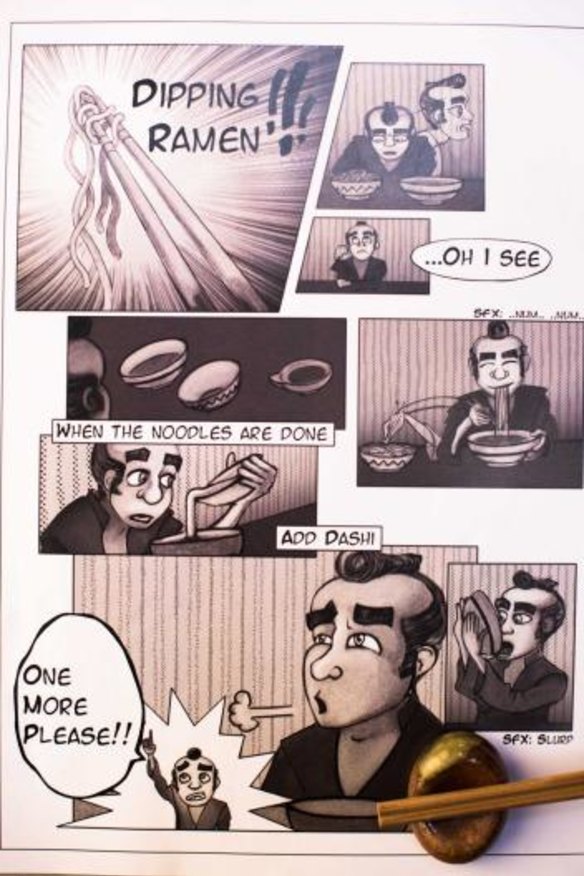
Menya SanDaime
Although the Japanese reckon the only good ramen comes from the Japanese, this Melbourne outpost of a Korean brand is popular with expats. This small, 24-hour diner has an energetic buzz with a collection of action figures by the open kitchen, a glass cage for the noodle maker and his machines - really good, fresh Japanese beer from the keg and choice of four ramen including the lip-smackingly good Tokyo-style tonkotsu ramen.
225 Russell Street, Melbourne, menyasandaime.com
Ikkoryu Fukuoka Ramen
Head down the dark stairs off Russell Street and enter the newest outpost of Ikkoryu Fukuoka Ramen, a brand developed by 45-year-old Japanese company Yamagoya Ramen. Come here for ramen inspired by those popular in the port city of Fukuoka with toppings that include tobanjan, a sauce made with red pepper, miso, vinegar, chilli and spices, or yuzukoshu, which is like a spicy version of Moroccan lemons.
Basement, 27 Russell Street, Melbourne, ikkoryu.com.au
Hakata Gensuke
Chef Kousuke Yoshimura brings the ramen of the Hakata area of Fukuoka to the city and Hawthorn with collagen-rich broth, noodles topped with pork, spring onion and black fungus as well as a version made with fried garlic and black sesame paste. The Hawthorn restaurant boasts aka tonkotsu ramen made with spicy cod-roe paste,
168 Russell Street, Melbourne and 4/860 Glenferrie Road, Hawthorn gensuke.com.au
This is a fun, fast, busy, family-friendly diner in the south-east suburbs with much less emphasis on the purity of the ramen experience and lots of add-ons and extras. While you can choose your choice of miso or shoyu tare and you can choose chicken karaage with your ramen, the broths are all nourishingly sticky.
73 Koornang Road, Carnegie, shyunramenbar.com.au
Shop Ramen
Learning ramen as a non-Japanese chef is a famously difficult exercise. But Pat Breen and Lydia Wegner, undeterred, ate their way through Japan, taking notes, then experimenting until they reached what they thought were great recipes. Melbourne agreed. Their shop on Smith Street, a bright slip of a thing with a blond communal table is jumping nightly. Serving a vegan ramen with rich almond milk-based broth helps their cause. As do salted caramel thick shakes, perfectly grilled slabs of pork belly, sunset yolked eggs and fluffy bao available with pork or tofu.
329 Smith Street, Collingwood, facebook.com/shopramen
Shop Ramen is the Ramen Pick of The Age Good Food Month creative director Gemima Cody.
What to drink with ramen
According to Masahiko Iga:
"People who love ramen soup usually start with a side dish, such as gyoza (Japanese dumplings) or karaage (fried marinated chicken). Try the fresh imported Japanese beer from the keg or try a Japanese craft beer. Japanese craft beers once proliferated but now only the only high quality craft brewers, such as Coedo, have survived.
"While some people stick with beer, for me, sake matches ramen perfectly. Umami-rich yamahai sake will always be good match while unpasteurised namazake is my most favourite.
"In Japan, the distilled grain spirit shochu, cooler-like chu-hai and plum liqueur ume-shu are popular to have with ramen.
"I think that ramen, with its complexity of flavours in the broth, work particularly well with some great Australian white wines such as Holly's Garden pinot gris."
Ramen at home
This is a recipe Masahiko Iga has been able to extract from a Japanese chef who wishes to remain anonymous. There are a few steps but take your time and slowly allow the broth to simmer. It should not boil but just gently simmer, allowing the fat to disperse into the stock. Skim away the floating bits and pieces, but not the fat, with a strainer. Look for fresh or frozen ramen noodles. We used Korean-made frozen "chopped noodles" we bought at a suburban Asian market and they were acceptable.
1kg chicken bones
1kg pork bones
2 onions
2 carrots
1 leek, washed and trimmed
1 bulb garlic
1kg pork neck, trimmed
1 tbsp sesame oil
2 cloves garlic, crushed
2 stems spring onion, chopped
1cm piece of ginger, peeled and finely grated
50ml sake
50ml mirin
120ml soy sauce
2 tablespoon honey
1 tbsp miso paste
6 eggs
1kg ramen noodles (defrost if frozen)
extra chopped spring onions
1. Boil five litres of water. Place the bones in a large heatproof bowl and rinse the bones with the boiling water. Drain the bones, spread them over two baking pans and bake them at 180C for 45 minutes or until golden. At the same time roast the onions on a small tray until brown. Place the roasted bones in a very large stock pot and cover with cold water. Place over a high heat and when water starts to simmer, reduce heat to low. Gently simmer for two hours, skimming scum from the top of the stock but not taking too much fat. This is essential to the flavour. Add the vegetables, including the whole bulb of garlic, and simmer for another two hours, skimming frequently. Strain the stock.
2. Meanwhile, make the pork and chasu sauce by seasoning the pork with a little salt and pepper. Heat the sesame in a heavy-based frying pan over high heat and brown the pork on all sides.
3. Remove pork and place in a baking tray. Make the tare, or sauce, by reducing the heat a little and add the garlic, spring onion and ginger.
4. After a few minutes add the sake and mirin and cook for a few minutes to evaporate the alcohol, add the soy sauce, honey and miso. Pour the sauce over the pork and roast in the oven at 180C for 45 minutes, rotating the pork every 15 minutes. Pour off the sauce and reserve, allow the meat to rest before slicing into three millimetre slices.
5. Cook the eggs for seven minutes from cold water to boiling. Remove, peel and cover the eggs in the sauce.
6. Cook the noodles as per instructions. Warm six large soup bowls and spoon a few tablespoons of the chasu sauce into the bottom of each and cover with hot broth. Top with sliced pork, egg (sliced in two) and spring onions. Serve immediately.
Serves 6
New Yorker Ivan Orkin captivates Tokyo
In 2007, Ivan Orkin, a middle-aged Jewish guy from Long Island, did something crazy. In the food-zealous, insular megalopolis of Tokyo, Orkin opened a ramen shop. He was a gaijin (foreigner) trying to make his name in a place that is fiercely opinionated about ramen. At first, customers came because they were curious, but word spread quickly about Orkin's handmade noodles, clean and complex broth, and thoughtfully prepared toppings.
Orkin became a celebrity – a fixture of Japanese TV programs and the face of his own best-selling brand of instant ramen. He opened a second location in Tokyo, and has now returned to New York City and opened two US branches.
In 2013 Orkin published Ivan Ramen, co-authored by Chris Ying (editor of Lucky Peach journal). It is essentially two books in one: a cookbook and a memoir that tells the story of his ascent from wayward youth to a star of the Tokyo restaurant scene.
Written with equal parts candor, humour, gratitude, and irreverence, Ivan Ramen is the only English-language book that offers a look inside the cultish world of ramen making in Japan.
As part of Good Food Month, Orkin and Ying will be in Melbourne and joining Andrew McConnell's team at Supernormal for Melbourne's first Ramen Rave featuring Orkin's ramen, karaoke, DJs and highballs. Get your tickets at melbourne.goodfoodmonth.com
Restaurant reviews, news and the hottest openings served to your inbox.
Sign up